The Israel Museum in Jerusalem is giving the public an unprecedented opportunity to explore ancient Egyptian relations with Canaan during the second millennium BCE in Pharaoh in Canaan: The Untold Story. This exhibition presents more than 680 objects, which reflect the rich cross-fertilization of ritual practices and aesthetic vocabularies between these two distinct cultures.
In this exclusive interview, James Blake Wiener of Ancient History Encyclopedia (AHE) discusses the exhibition and the countless ties that bound ancient Egypt to Canaan with Dr. Eran Arie, Curator of Iron Age and Persian Period Archaeology at the Israel Museum.

Reconstructed collar from the Megiddo Treasure House. Lachish, 14th century BCE, Faience. Collection of Israel Antiquities Authority. Photo © The Israel Museum, Jerusalem, by Elie Posner.
JW: Curator Eran Arie, welcome to Ancient History Encyclopedia (AHE), and thank you for speaking to me about Pharaoh in Canaan: The Untold Story. I extend you my congratulations on having put together a remarkable presentation of ancient Egyptian and Canaanite artifacts together with Dr. Daphna Ben-Tor, your co-curator.
3,500 years ago, mutual cultural influences and political fluctuations marked the relationship between ancient Egypt and Canaan. Around 1700 BCE, the Hyksos, a foreign dynasty of Canaanite origin, conquered northeastern Egypt. Following their expulsion some 150-100 years later, Egypt entered a period marked by military conquest and cultural finesse during the New Kingdom (c. 1550-1077 BCE).
I have read that the Canaanites absorbed technological and artistic innovations from Egypt, and that the Egyptians, in turn, adopted some Caananite deities and technologies. How does Pharaoh in Canaan showcase the exchange stimulated by the Egyptian rule over Canaan?
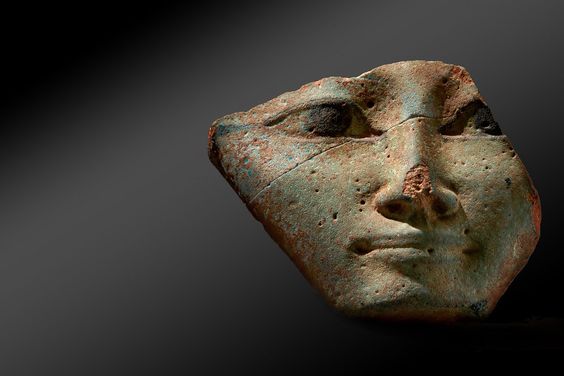
Hathor mask. Timna, 13th-12th century BCE, Faience. Photo © Eretz Israel Museum Tel Aviv, by Leonid Padrul-Kwitkowski.
EA: The mutual influences between Egypt and Canaan are not a surprise. As neighboring cultures, geographically so close to one another, it is only natural that ideas and materials would be exchanged. Yet, the big surprise is in the nature of these relations. There is no doubt that Egypt was the big empire of that time, and that its culture, with its mature hieroglyphic writing system, was more evolved than the Canaanite culture. Therefore, it is especially interesting to see that the great Egyptian Empire was influenced by its Canaanite province in artistic, technological, and even spiritual matters. Egyptian imitations of both everyday and precious tools and vessels are very common in Canaan during this period. Some of the artifacts include jewelry, cosmetic containers, mirrors, razors, ivory inlays, game boards, figurines, and also pottery and stone vessels. All of these were both imported from Egypt, but also locally manufactured in Canaan, either for the Canaanite elite or the Egyptian troops and administrators who lived here.
The area where Canaanite culture had the most influence over Egypt was in religious matters and Egyptian cults. In this period, a group of Canaanite deities was “accepted” into the Egyptian pantheon. Temples of these gods and goddesses are known from Egypt, and they now appeared on Egyptian monuments as worshiped entities, both by private persons or the pharaoh himself. Additionally, in other aspects of life, one can identify the Canaanite effect. For example, after thousands of years of Egyptian pottery production with handle-less jars, in this period, Egyptian amphorae are produced with handles, as an imitation of the Canaanite jars, so well-known all around the eastern Mediterranean. Another case is the first use of scimitars (curved swords) — which originated in Canaan — by the Egyptians. Not only were scimitars used during this period in Egypt, but they become an Egyptian symbol of power; one that gods offer the rulers as a sign promising their victory.
“For me, having worked as a field archaeologist in the past, the most challenging part of the project was locating and collecting all of the architectural elements that were found here in Israel during the Egyptian rule over Canaan…” ~Curator Eran Arie

Lid of anthropoid sarcophagus. Tel Shadud, 13th century BCE, pottery. Collection of Israel Antiquities Authority. Photo © The Israel Museum, Jerusalem, by Elie Posner.
JW: Pharaoh in Canaan features an array of handsome ancient Egyptian scarabs and amulets, which ancient Canaanites used in their own burials, as well as anthropoid coffins and various stelae made locally by Egyptians stationed throughout the region.
What are the other highlights in your opinion, Curator Arie? In what ways do these special artifacts demonstrate the cross-fertilization of ritual practices and aesthetic tastes between these two ancient cultures?
EA: There are many important artifacts in the exhibition that reflect the mutual influences between Egypt and Canaan. Thus, out of the more than 600 objects on display, it is very hard to choose highlights. Most of the artifacts on display were found in excavations in Israel, and they are dated to the Late Bronze Age and Early Iron Age (c. 1500-1130 BCE). All of them reveal the political and cultural relations between these two powers.
Here are some highlights from the exhibition in my opinion:
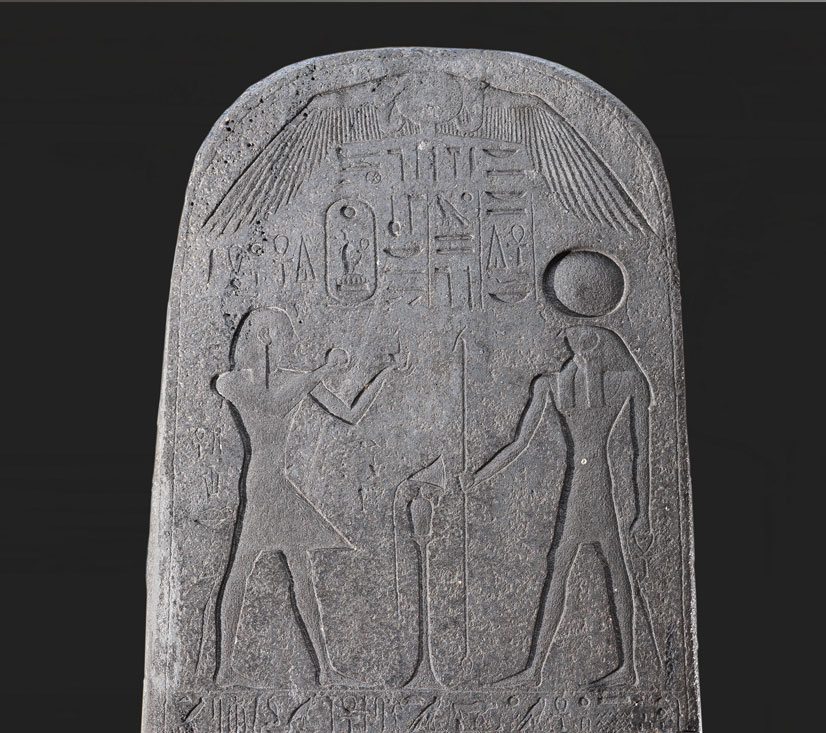
Victory stela of Seti I. Beth Shean 13th century BCE, Basalt. Collection of Israel Antiquities Authority. Photo © The Israel Museum, Jerusalem, by Elie Posner.
- The Great Stele of Seti I
Today, we commemorate military victories by erecting memorials — it was no different in ancient times. This monumental stone, erected in Beth Shean by Pharaoh Seti I (r. 1290-1279 BCE), was designed to immortalize an Egyptian victory over Canaanite forces some 3,300 years ago. The monument was carved out of local basalt stone by Egyptian artists working in Canaan. Cut into the main part of the stele are twenty-two lines of hieroglyphic script, read from right to left. The inscription begins with a date: “Year One” of the king’s reign, the third month of the summer, the tenth day. The following thirteen lines are devoted to the pharaoh’s titles, and words of praise for his courage and glorious achievements. The last part of the inscription describes the Egyptian victory in the area of Beth Shean. Did the pharaoh himself take part in the military campaign that restored Egyptian control over Beth Shean? The answer to this question is controversial. But, as was usual with Egyptian military victories, the pharaoh made sure he would be given credit for the success of his troops and their commanders.
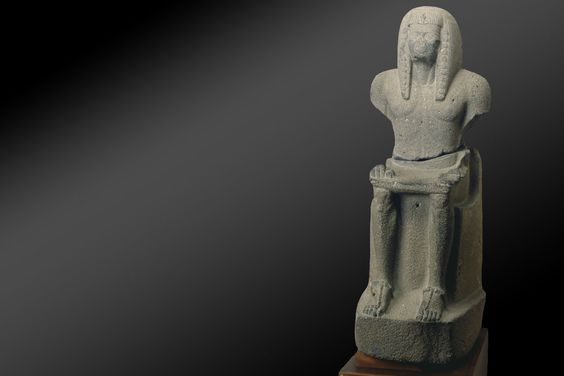
Statue of Ramesses III. Beth Shean, 12th century BCE, Basalt. Collection of Israel Antiquities Authority. Photo © The Israel Museum, Jerusalem, by Abraham Hay.
- The Statue of Ramses III
The statue of Ramses III (r. 1186-1155 BCE) was discovered at Beth Shean, which was an Egyptian stronghold at the time of the Bronze Age collapse. His names are inscribed at the shoulders of the statue. The Egyptian empire had weakened during the reign of Ramses III, but Egypt was still able to maintain its rule over Canaan. This is the only life-size statue of an Egyptian pharaoh ever found in Israel. The statue was carved out of local basalt stone, clear evidence that it was made in Canaan. However, the artistic style tells us that the sculptor was Egyptian. Having said that, the statue has some peculiar stylistic features: Crudely carved facial features, the design of the wig, and especially the gap between the legs. These departures from traditional rules of Egyptian sculpture, suggest that the statue was a provincial work, created far from the Egyptian cultural centers.
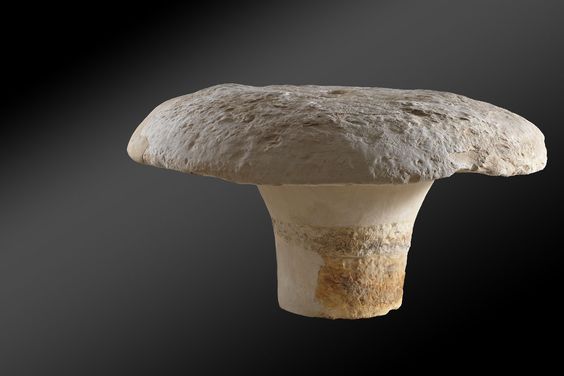
Papyrus-shaped capital. Beth Shean, 13th-12th century BCE, Chalk. Collection of Israel Antiquities Authority. Photo © The Israel Museum, Jerusalem, by Elie Posner.
- Column Capitals
Two impressive column bases were found in the central hall of the Egyptian governor’s palace at Beth Shean. The columns placed on these bases were carved of cedar tree trunks and have not survived, but the two capitals displayed in the show belonged to these columns. Capitals of this type, in the form of a splaying papyrus flower, were very popular in Egypt. They were probably decorated in bold colors, which unfortunately did not survive. Unlike the wooden Beth Shean columns, Egyptian columns were usually made of stone. These two capitals were found together in excavations at Tel Beth Shean 90 years ago, during the period of the British Mandate in our region. The capitals were separated at the time. One was removed to the Rockefeller Museum in Jerusalem, where it was put in storage and never displayed. Its twin was left on the tel, and deteriorated badly with time. The capitals were reunited for this exhibition. Thanks to the cooperation of the Israel Antiquities Authority and the Nature and Parks Authority, the capitals underwent professional conservation treatment at the Israel Museum laboratories, and are now on public view for the very first time.
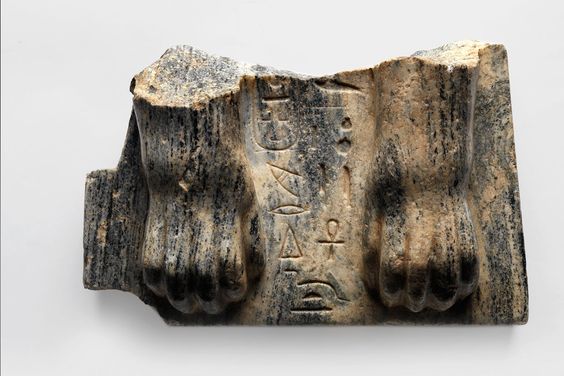
Fragment of a sphinx of Menkaure (Mycerinus). Hazor, 26th century BCE, Gneiss. Collection of Israel Antiquities Authority. Photo © The Israel Museum, Jerusalem, by Elie Posner.
- A Sphinx Fragment from Hazor
The sphinx is a mythical creature, a hybrid of a lion’s body and a human head, meant to represent the Egyptian pharaoh. Only the front paws of our sphinx have survived. But with a stroke of good fortune, the name of the Pharaoh Menkaure (fl. 2530 BCE) is carved between the paws. The size of the fragment allows us to calculate the dimensions of the full original sculpture. It would have been about 170 cm (66 in) long, and weighed an estimated half a ton. It was a monumental sculpture, made in a royal workshop in Egypt. The sphinx was already more than a millennium old when it was given as a valuable official gift to the ruler of Hazor or presented to a local temple. We do not know why this particular sculpture was chosen; but given its enormous weight, we can assume it was sent by sea from Egypt to one of the Mediterranean ports – either Akko or Tyre – and then brought overland to Hazor. It took huge efforts to transport the sphinx such a long way and this surely indicates the importance of the city in the eyes of the Egyptians.

Egyptian stela showing worshipers of Canaanite deities. Deir el-Medina, 13th century BCE, Painted limestone. Museo Egizio, Turin Photo © Turin Museo Egizio.
- An Egyptian Stele from Turin, Italy
The wonderful state of preservation of the stele allows us to appreciate the bold colors with which it was painted. It is a private Egyptian stele showing veneration of a divine triad. Surprisingly, two out of the three are Canaanite and not Egyptian gods. The stele is divided into two sections. In the lower section, the scribe Ramose and his wife are seen kneeling in a gesture of veneration toward the three deities depicted in the upper section. The central deity is the Canaanite goddess Qedeshet, standing naked on the back of a lion. Her figure carries a connotation of eroticism and fertility. On the right is the Canaanite warrior-god, Reshef, who was associated also with healing and fertility. On the left is the Egyptian god, Min-Amun-Ra, whose role as god of fertility and male potency is clearly reflected in his iconography. The inscriptions on the stele identify all five figures. Egyptian worship of Canaanite gods is the most conspicuous expression of the cultural impact of the Egyptian rule in the Levant, especially during the Ramesside Period (1292-1069 BCE).
JW: Many artifacts exhibited in Pharaoh in Canaan come from the site of Beth Shean, which is located at the junction of the Jordan Valley and Jezreel Valley. Why did the ancient Egyptians base themselves here, and what does material evidence suggest they were doing in Canaan?
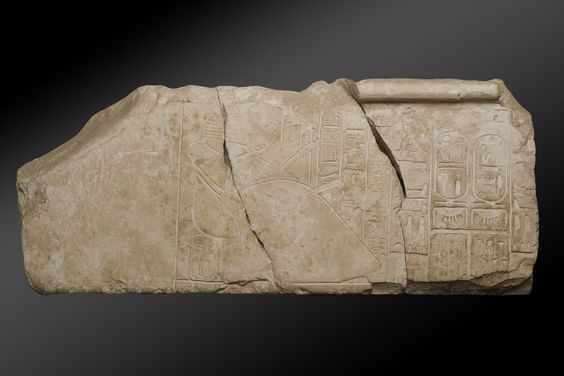
The Beth Shean Gate Lintel inscribed with Ramses III’s names. 12th Century BCE Beth Shean, Limestone. Collection of Israel Antiquities Authority. Photo © The Israel Museum, Jerusalem, by Elie Posner.
EA: Beth Shean was one of three Egyptian strongholds that were constructed in order to control the local Canaanite population in southern Canaan. (Northern Canaan includes modern Lebanon, the Syrian shore, and the southern parts of Syria — hence it is not part of our show). Gaza, was the southernmost stronghold, and hence the most important one, due to its proximity to Egypt. Jaffa controlled the central part of modern Israel, and Beth Shean was responsible to rule the fertile northern valleys of Israel and, of course, the international road from Egypt to Mesopotamia. Due to the vast excavations of Beth Shean by two archaeological expeditions — the first from the Pennsylvania University from 1921 to 1933 and the second of the Hebrew University in Jerusalem from 1989 to 1996 — the site became crucial to the understanding of the Egyptian presence in Canaan.
It appears that an Egyptian governor was based in each stronghold. The local Canaanite rulers arrived from time to time to visit these fortresses. They had to give reports of their actions, offer presents to the pharaoh, and bring their annual taxes. Several public buildings were excavated in Beth Shean, and the most important ones are temples and the palace of the Egyptian governor. The finds attest that the site was an Egyptian capsule inside Canaan. Egyptian administrators, soldiers, and artisans lived there as if they were still living along the Nile River. Most of the material culture that was found in Beth Shean was Egyptian, but the use of local pottery vessels for cooking and baking suggest that only Egyptian men lived in Canaan, while local Canaanite women served them, as wives or slaves.
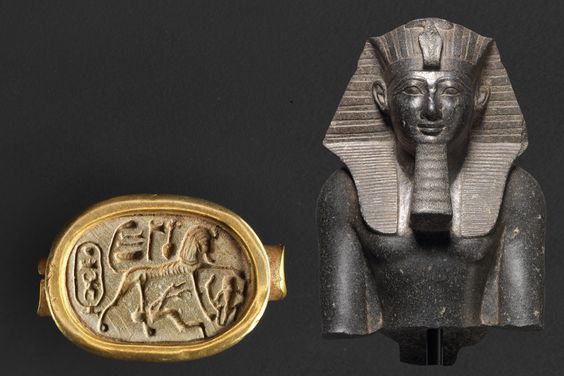
Bust of Thutmose III. Egypt, ca. 1458-1425 BCE, Grandiorite. Kunsthistorisches Museum, Vienna. Photo © Kunsthistorisches Museum Vienna. Royal-name scarab of Thutmose III as a sphinx, defeating his enemies. Collection of Israel Antiquities Authority. Photo © The Israel Museum, Jerusalem, by Elie Posner.
JW: Curator Arie, can we say that the ancient Egyptians left a discernible or tangible legacy in Canaan? What was the consequential outcome of their mutual encounter? Interaction between the two peoples seems to be a forgotten chapter in the respective histories of the region.
EA: Actually, not long after the Egyptian withdrawal from Canaan, the Canaanites disappear from the stage of history, and we then see the Israelites and their Aramaean, Phoenician, Ammonite, Moabite and Edomite neighbors playing powerful roles in this geographical arena. The Egyptian legacy over Canaan was probably absorbed into these “newer” cultures.
Nevertheless, I think that the most important consequence of the interactions between Egypt and Canaan is something that still affects each one of us in the western world. I am referring to the invention of the alphabet. Surprisingly, it was created by Canaanite miners employed in the Egyptian turquoise mines at the site. The scripts that preceded it — Mesopotamian cuneiforms and Egyptian hieroglyphs — were exceedingly complex and consisted of hundreds of signs. Consequently, few individuals could master them. The alphabetical system, by contrast, based on less than thirty signs (borrowed from the Egyptian hieroglyphs), simplified reading and writing greatly, and eventually became accessible to all.
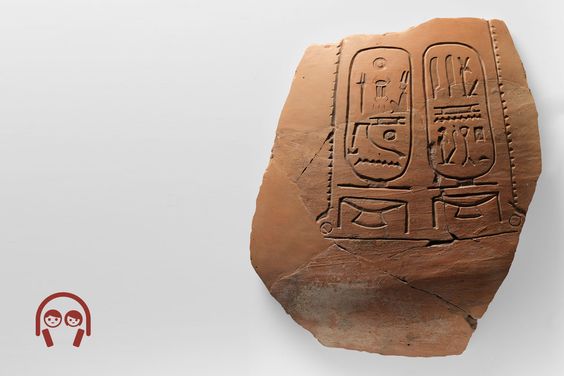
Lid of anthropoid sarcophagus. Tel Shadud, 13th century BCE, pottery. Collection of Israel Antiquities Authority. Photo © The Israel Museum, Jerusalem, by Elie Posner.
The ancient alphabet (Proto-Sinaitic script) was a pictorial script in which each pictogram symbolized the first consonant of the object it depicted; for instance, the pictogram of a fish (dag in Canaanite) represented the consonant d. Two centuries later, a similar script began to be used in Canaan (Proto-Canaanite script), but it was only around 1000 BCE that these pictograms completed their development into abstract linear forms. The Phoenicians adopted the alphabet and disseminated it throughout the Greek world. From there it spread to all of the people of the West. Needless to say that this invention decisively influenced the development of human culture, James!
JW: This is your first exhibition at the Israel Museum, and you have worked on this show for the last three years. What was the most rewarding aspect of putting this show together?
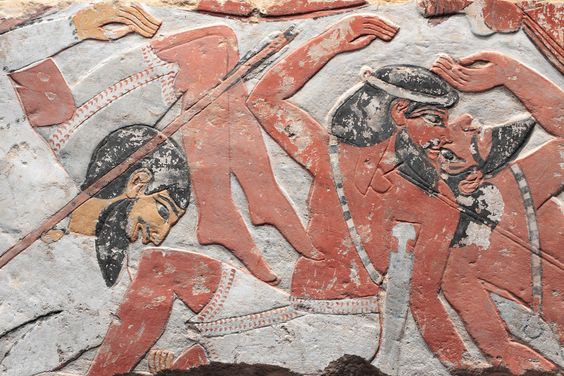
Relief fragment depicting Canaanites defeated in battle. Thebes, c. 1400 BCE, Painted Limestone. The Metropolitan Museum of Art, New York. Photo © The Metropolitan Museum of Art Image. Source: Art Resource, NY.
EA: For me, having worked as a field archaeologist in the past, the most challenging part of the project was locating and collecting all of the architectural elements that were found here in Israel during the Egyptian rule over Canaan. While several are in Pennsylvania University (and we decided not to borrow them for our show), most of them were in museums, institutions and storehouses in Israel. We decided that we have to show all of the impressive monuments, after their reconstruction, to give the visitor a genuine feel for the architecture of that time. My biggest surprise was to find several architectural elements that had been excavated some 90 years ago on Tel Beth Shean. They have been forgotten since the time of the excavation, and it was only two years ago, after Professor Amihai Mazar of the Hebrew University, Jerusalem, brought our attention to these incredible finds, that we brought them to our restoration laboratories.
All in all, we were able to show five impressive reconstructions: two victory stelae of Seti I standing on their original bases from Beth Shean, a reconstruction of the gate of the palace of the Egyptian governor of Beth Shean, and two papyrus shaped capitals, that adorned the same palace. Moreover, this is the first time that four large fragments from a monumental gate of the fortress of Jaffa are displayed together in a beautiful reconstruction. Indeed, the way our public reacts to these reconstructions was worth the efforts…
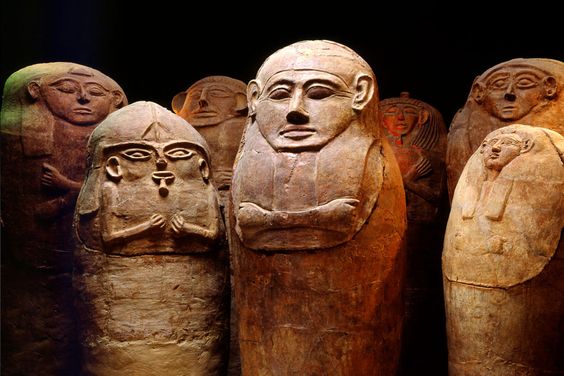
Funeral customs — anthropoid sarcophagi. Deir el-Balah, 13th century BCE, Pottery. Collection of Israel Antiquities Authority. Photo © The Israel Museum, Jerusalem, by Nachom Selpak.
JW: Curator Arie thanks again for speaking to me. I look forward to covering more shows at the Israel Museum in the near future!
EA: Many thanks James, and I would like to thank Ancient History Encyclopedia for the opportunity to expose the narrative of the exhibition to your audience.
Pharaoh in Canaan: The Untold Story will be on display at the Israel Museum in Jerusalem until October 25, 2016. An exhibition audio guide with further information can be accessed online.
 Dr. Eran Arie is the Frieder Burda Curator of Iron Age and Persian Period Archaeology at the Israel Museum, Jerusalem. He excavated in Megiddo (Armageddon) as part of the Tel Aviv University Expedition from 1998-2014. He wrote his doctoral thesis on the transition from Bronze to Iron Ages in the Jezreel Valley under the supervision of Professor Israel Finkelstein at Tel Aviv University. His expertise lies in pottery of the Iron Age in northern Israel, and he teaches an academic course on ancient pottery of Israel at Bar-Ilan University.
Dr. Eran Arie is the Frieder Burda Curator of Iron Age and Persian Period Archaeology at the Israel Museum, Jerusalem. He excavated in Megiddo (Armageddon) as part of the Tel Aviv University Expedition from 1998-2014. He wrote his doctoral thesis on the transition from Bronze to Iron Ages in the Jezreel Valley under the supervision of Professor Israel Finkelstein at Tel Aviv University. His expertise lies in pottery of the Iron Age in northern Israel, and he teaches an academic course on ancient pottery of Israel at Bar-Ilan University.
Headline Image: Canaanite amulet of a schematic nude goddess in Egyptian style. Tel el-Ajjul, 15th century BCE, gold. Collection of Israel Antiquities Authority. Photo © The Israel Museum, Jerusalem, by Elie Posner.
All images featured in this interview have been attributed to their respective owners. Images lent to AHE by the Israel Museum, Jerusalem have been done so as a courtesy. Interview edited by James Blake Wiener for AHE. Special thanks is extended to Mr. Ran Lior, Head of Marketing at the Israel Museum, Jerusalem, for helping to facilitate this interview. Unauthorized reproduction is strictly prohibited. All rights reserved. © AHE 2016. Please contact us for rights to republication.
top

